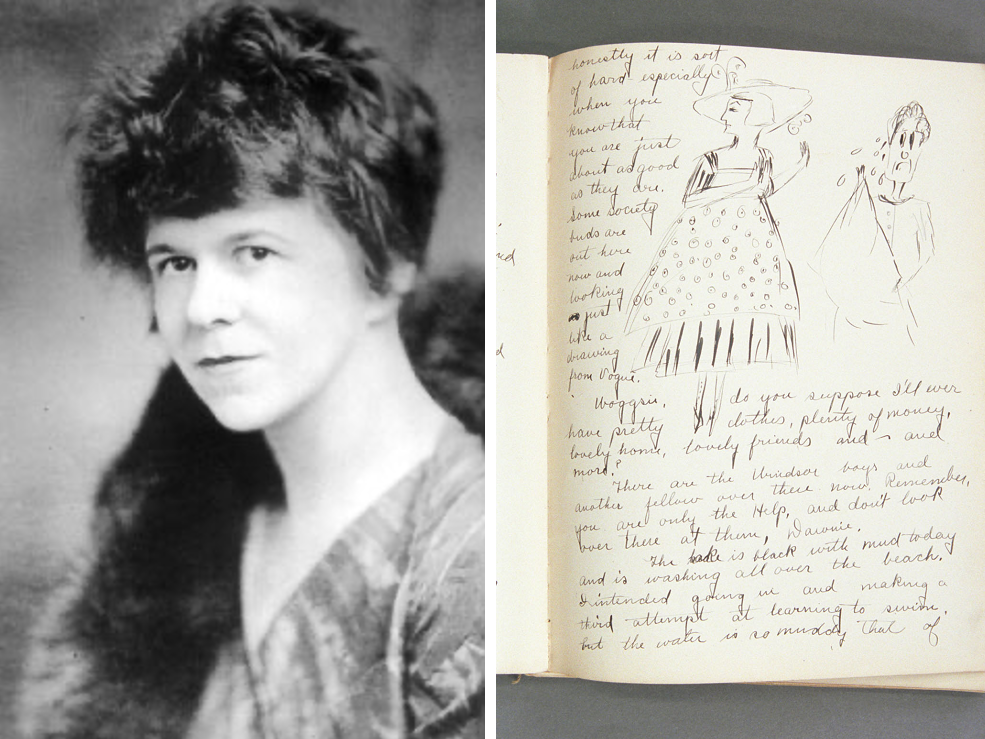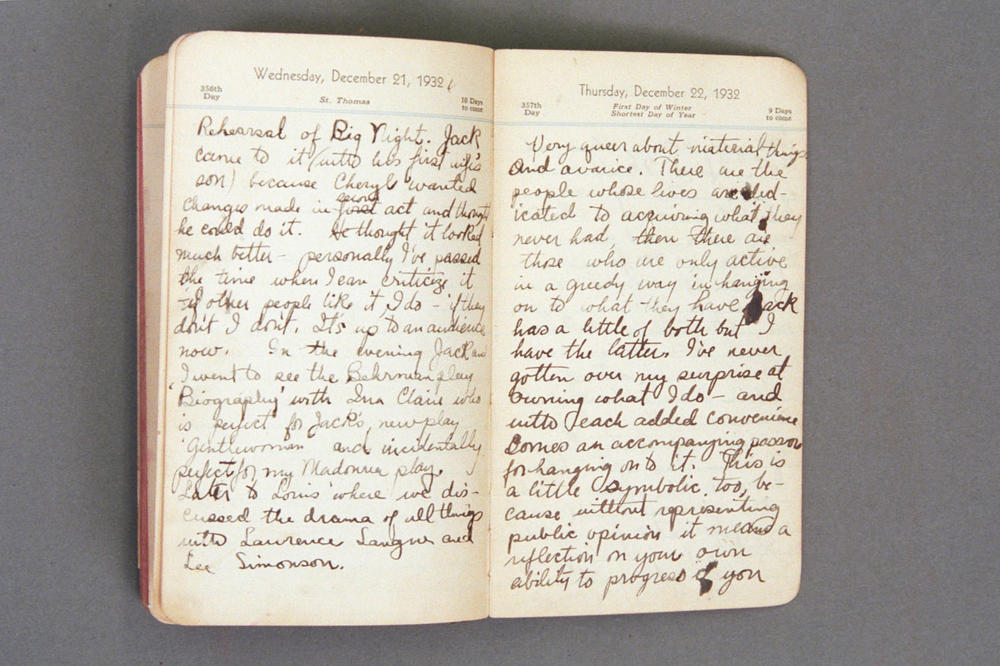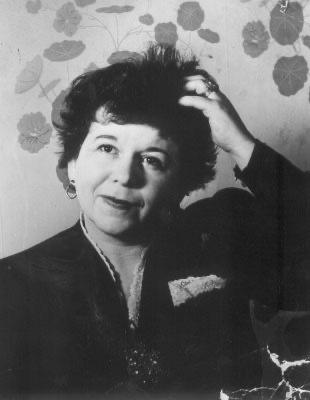Section Branding
Header Content
Her writing was admired by Hemingway. Then her books — and body — disappeared
Primary Content
This is the third story in The Unmarked Graveyard: Stories from Hart Island series from Radio Diaries. You can listen to the next installment on All Things Considered next Monday, and read and listen to previous stories in the series here.
Dawn Powell infiltrated the writing world by hanging out in bars and taverns around New York's Greenwich Village in the 1920s, rubbing shoulders with the likes of Ernest Hemingway and Edmund Wilson.
"She came from nowhere, she was no one," writer Fran Lebowitz told Radio Diaries.
But Powell had a voice. She had style. And she rose from obscurity by turning her gaze on the city of New York itself and its cast of characters. Over the coming decades, Powell wrote novels, diaries and more than a dozen plays — earning her renown, and even a National Book Award nomination.
Then, in 1965, she died. What happened next didn't go according to script.
A voice lost to the world
Powell had been clear in her will: she wanted her body to be donated to the Weill Cornell Medical Center for research. Yet five years after her death, when Cornell asked her executor, Jacqueline Rice, what to do with her remains, Rice left the decision up to the center.
So, unbeknownst to her family and friends, Powell was buried on New York's Hart Island — America's largest public cemetery. Then, all of her work went out of print.
A generational talent of New York was buried in its heart, but lost to the world and those who knew her.
Hart Island, located off the coast of the Bronx, has no headstones and no plaques. It's often seen as a place for those who went unrecognized in their lifetime — not for well-known writers.
Powell had been writing stories since she was a child. Growing up in Ohio, she endured considerable emotional abuse from her stepmother and often used writing as an escape. In 1918, she left Ohio for New York City, with dreams of being a writer.
"She knew that she was smart enough, good enough to be very good in New York, which is the most competitive place in the world," Lebowitz said.
Powell's humble beginnings in the bars of Greenwich Village turned into a career. In the coming years, she wrote witty pieces on New York life for magazines like The New Yorker and Esquire. Her career picked up steam when she began writing novels about New York: satirical, risque fiction about people who'd come to the city from a small town and indulged in its joys and vices. Her most well known novels include A Time to Be Born (1942) and The Wicked Pavilion (1954).
"She was a very smart, tough, sarcastic, woman who put all of that into her books," said Tim Page, a critic and author of Dawn Powell: A Biography. "She made fun of millionaires and communists. She basically thought human beings were silly and frivolous, but she loved them."
Powell's writing reflected her personal life. Her characters were often young people who ached for success and recognition, but rarely got it. Though her work was in the public eye (her last novel, The Golden Spur, was a finalist for the 1963 National Book Award), she did not reach the level of fame of other writers, male or female, in her era.
"Some critics thought she was mean," Page said. "All the very famous women writers were usually ending their stories with a man and a woman falling in love and living happily thereafter. Dawn had seen enough of life to realize, well, sometimes that's the case but it's not what usually happens in the world."
Powell struggled with money for much of her life. She and her husband, Joseph Gousha, had a disabled son who needed costly medical care. By the end of her life, she also needed medical care of her own. She developed intestinal cancer, which led to her death.
While her will was specific about her body going to the Weill Cornell Medical Center, it didn't specify what to do with her body after its donation. In addition to being Powell's general executor, Jacqueline Rice was also her literary co-executor, largely responsible for her literary estate. When her client died, Rice simply stopped responding to inquiries from publishers and filmmakers. It was some time before Rice told Powell's family about where she had ended up.
Years later, Powell's great-niece Vicki Johnson was told by her mother about the burial on Hart Island, also known as a Potter's Field.
"My mom told me it was a Potter's Field, and it was just a place where people are buried who didn't have any money or no family to take care of them," Johnson said. "My grandparents would have certainly found a better resting place for her than where she was buried."
The effort to bring Powell's work back
Powell isn't the only well-known person buried on Hart Island. There's former child actor Bobby Driscoll, who starred in some of the most iconic Disney films of the time, like Treasure Island and Peter Pan — and even won a Juvenile Oscar by the age of 13.
Driscol fell into a pattern of substance abuse and run-ins with the law in his teenage years, ranging from drug smuggling to assault. He was found dead in his Greenwich Village apartment at 31. When no one claimed his body, he ended up on Hart Island.
The cemetery is also home to Rachel Humphreys — the muse and lover to Lou Reed, and the inspiration for several songs on his album Coney Island Baby. Though her official cause of death remains unknown, Humphreys died at the age of 37 at St. Clare's hospital, known for housing AIDS patients. Hers was among the many bodies sent to Hart Island during the AIDS epidemic.
Johnson and others insist Powell wouldn't have minded being buried at Hart Island.
"I think she'd be a little amused by the fact that she's buried with a Disney star and a rock and roller," Page said. "She loved New York. She told the truth about New York and I'm not sure she'd want to be anywhere else."
Though Powell's descendants have chosen not to remove her body from Hart Island, there has been a considerable effort to unbury her work. In 1987, her writer and friend, Gore Vidal, published an article in The New York Review of Books, praising Powell as one of American literature's lost greats. The article ignited interest in Powell in the writing world.
Steerforth Press also published a volume of Powell's diaries, edited by Page, in 1998. The Library of America put nine of her novels back in print in 2001.
These days, Powell has gained a cult-like following. Celebrities like Julia Roberts and Anjelica Huston have tried turning her books into films, and she's gotten a shout-out on the TV show Gilmore Girls.
"There will come a time when people will realize that she's one of America's greatest writers," Page said.
This story was produced by Mycah Hazel of Radio Diaries. It was edited by Deborah George, Ben Shapiro and Joe Richman. Thanks also to Nellie Gilles, Alissa Escarce, and Lena Engelstein of Radio Diaries.
This story is the third in a series called The Unmarked Graveyard: Stories from Hart Island. You can find other stories from Hart Island on the Radio Diaries Podcast.
Copyright 2023 NPR. To see more, visit https://www.npr.org.




